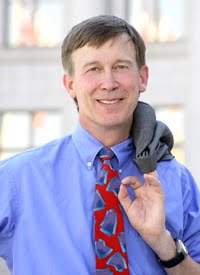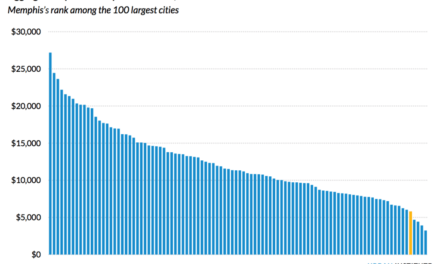In 2009, we published a series of blog posts about great city mayors, and we began with Denver Mayor John Hickenlooper, now governor of Colorado. He was the ultimate outsider candidate with little name recognition who not only got elected but developed such broad regional appeal that voters – inside and outside of Denver itself – voted to tax themselves to build a light rail system. He makes a persuasive case study for how transformative leadership can affect a city.
Great Mayors: Denver’s John Hickenlooper
A geologist and restaurateur by profession, he’s been a remarkable mayor who built record approval ratings throughout his entire region and invested them to produce breathtaking results – nationally praised homeless program, a regional light rail system, growth plans, downtown development, and more.
Most of all, he build a management team that is the envy of most cities, and he did it by taking a distinctly nonpolitical view of it. His criterion for talent was simple: proven leaders in their field who would demand excellence and results. For the head of parks or schools, he asked his transition team to identify the best in the nation and send him a couple of recommendations without any consideration about who gave him money or who worked for his election. The outcomes have proven him right.
It seems to us that hallmarks of his transition period are that it focused on talent and he kept the process tight — six weeks.
The Most Precious Resource: Time
Another hallmark from the launching of his administration was that time matters. He moved assertively because he had a window of opportunity to reinforce the message of change that the voters had demanded at the polls. Often, the first 60 days set the narrative for a new mayor for his entire term.
It comes from the intense scrutiny of every action that the media, and subsequently the public, define and repeat a narrative, and Mayor Hickenlooper’s approach shaped and reinforced the narrative that he wanted for his administration. Incidentally, the consolidated government over which Hickenlooper is mayor has been a powerful platform for setting a bold vision and executing the strategies to make it happen.
Here a report on Mayor Hickenlooper and his advice to the Economy League of Greater Philadelphia as part of its series, Profiles in Leadership.
Lessons from a Brewpub
We started our Great Mayors series to answer a simple question: what does a great mayor look like?
We weren’t expecting to find out that, sometimes, a great mayor looks like a brewpub manager. But John Hickenlooper is used to surprising people.
He surprised his friends and family in Narberth by morphing from an awkward, unambitious kid into a dynamic, successful businessman. He surprised his bankers by turning a risky brewpub venture into a catalyst for a neighborhood’s development. He surprised everyone in Denver by beating the pants off of a field of well-established politicians and becoming mayor.
And he surprised our audience by explaining that restaurants and city halls aren’t that different. “I think that any candidate is greatly improved by having spent a few years running a big, popular restaurant,” he said. “Whether it’s the restaurant or a big city, you never have enough money. You have a diverse group of people you’ve got to weld into a team. And the public is always ticked off about something.”
In 2003, Hickenlooper rode a wave of ticked-off voters to victory. Public frustration with Denver’s political establishment had opened the door to an outsider candidate like him. Hickenlooper seized the opportunity not by railing against his opponents but by presenting a positive vision for the city. He emphasized the need for teamwork. He vowed to improve city services and balance the budget. He promised to end the old-school game of political insider-ism and put the best possible person in every city job.
So far, he has delivered enough that his re-election is virtually assured. He balanced the budget despite declining revenues. He passed key civil service reforms. He reached far beyond his circle of friends and supporters to find qualified, diverse appointees. He helped end years of city-suburb political warfare, paving the way for a groundbreaking regional transportation initiative. TIME Magazine has called him one of America’s top big city mayors, and he faces no significant competition for his second term.
How did he do it? He turned to the lessons he learned on the brewpub floor.
Lesson One: Listen
As a candidate, Hickenlooper listened to local businesspeople and found out that tax revenues were more likely to shrink than to grow. That allowed him to craft a smart budget that helped him win early endorsements from the local papers. He listened to leaders in the towns and suburbs surrounding Denver. That helped him end years of animosity and start money-saving, region-growing regional projects. He listened to average Janes and Joes all around Denver, and that helped him grasp the importance of improving city services and restoring faith in government.
And from the minute he launched his campaign, he listened to his own gut instincts. “At that first meeting, we’re sitting there with a bunch of political consultants,” he recalled. “There’s six other candidates- it’s almost like a made-for-TV movie – there’s the Greek former police chief, the Latino former city auditor, the African American state senator – all the way down the list. And one of the people said, ‘You’re at 3 percent in the polls. If you’re going to distinguish yourself, you’ve got to pull down one of these frontrunners.’ And my wife and I looked at each other and said, ‘Well that’s exactly the direction we’re not running.’
“We never did opposition research. We never did a negative ad. We never attacked. We tried to run a campaign where we said, ‘We’re going to hire the best person for the job for every single job in the city.’ We were going to focus on being transparent, inclusive, and collaborative in a way that no one in the city has seen.” The message worked: Hickenlooper won 65 percent of the final vote.
Lesson Two: Know Your Real Budget
One of the first things that candidate Hickenlooper did was make the rounds of local businesses. Based on what he heard, along with other research, he decided that instead of tax growth, Denver was about to see a significant decrease in tax revenue; so he made up a budget, took it to the newspapers, and won early endorsements.
The next thing he knew, he had jumped to 33 percent in the polls, with his nearest competition at 15. “I still remember my wife reading the details,” he said, “and she was not terribly happy about this. She lowered the newspaper so just her eyes were above it and said, ‘You never told me you were going to win.’”
But he did win, and his projections proved correct. But he arrived armed with the mandate he needed to make tough budget cuts.
Lesson Three: Know your Real Competition
When Hickenlooper opened his brewpub in a half-forgotten downtown neighborhood, his employees thought he was crazy when he put ads for other local restaurants in his restrooms. “The other restaurants couldn’t believe it. Our staff came up to me and said, what are you doing?” he recalled. “I said, they’re not our competitors. You’ve got to look at our self-interest in broader way. They’re really our allies. Our competitor is the TV set. We’ve got to work together to get people off the couch and out to enjoy life.”
That attitude helped revitalize what’s now known as LoDo – for Lower Downtown – and Hickenlooper brought it to the mayor’s office. One of the first things he did was throw a party in his loft for every regional county commissioner and their spouses. “I gave a two-minute speech: ‘The history of divisiveness, and us trying to get benefit at your expense, is over. And from now on, the City of Denver will do everything we can to help the suburbs,” he recalled. “I got a huge round of applause. There was this tremendous hunger there.”
Similarly, he reached out to the Republican governor, who’d had epic battles with Hickenlooper’s Democratic predecessor, Wellington Webb. “On my first day in office I walked across the green. I spent about an hour and a half with him, and I said, ‘I guarantee you I will never embarrass you for political gain. We agree on about 90 percent of the stuff. It’s crazy for us to get in fights over these other things.”
Why reach out? Because just as a successful brewpub needed a successful LoDo, a successful Denver needs a successful Colorado. “Denver doesn’t compete anymore with Seattle or San Diego,” he said. “We’re competing with metropolitan Shanghai. And metropolitan Bombay. If we don’t begin working together at a much higher level, we’ll find that not just our grandchildren’s jobs but our children’s jobs will have gone away.”
Lesson Four: Never Stop Building Your Team
Don’t ever expect to see Hickenlooper pat himself on the back. As he talks about Denver’s successes, he credits his partners, his predecessors, his employees, his advisers, his wife, his parents – everyone but himself. This is no accident. It’s part of his strategy of keeping his team together.
Restaurants depend on a team of diverse people with many backgrounds and skill sets, all of whom have particular needs if they are to get their jobs done. Cities depend on the same thing. When he came into office, Hickenlooper made sure that he brought in a staff of appointees who were not only highly qualified, but diverse and representative, with connections to all parts of the city’s social and political culture. He appointed one of his competitors for mayor as a leader in his transition. He established transition teams that could reach far beyond his personal circle to find qualified candidates for appointment. He made a highly visible effort to put a team in place that Denver’s citizens could trust.
And he never stops building up his teammates, listening to their needs in private, and praising them in public whenever he can. He praises the city employees who helped him trim Denver’s budget. He praises the suburban officials who helped make transit reform a reality. He happily declined to put his picture up in the Denver airport, substituting pictures that celebrate regional landmarks.
“Symbolic stuff really matters,” he said. “You end up coming out better in the end. By taking your own picture down, it’s as if you had a bigger picture up there.”
***
Join us at the Smart City Memphis Facebook page for daily articles, reports, and commentaries that are relevant to Memphis.






Closer to home, Mayor-elect Strickland could learn a lot from Karl Dean who was the architect of much of Nashville’s success.